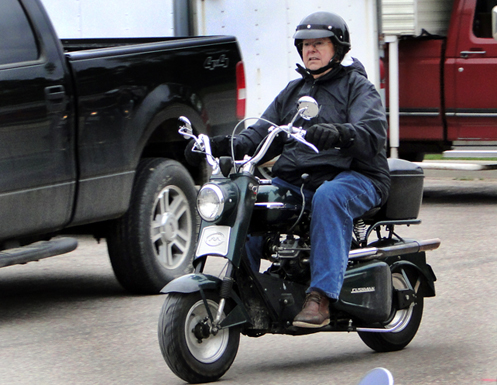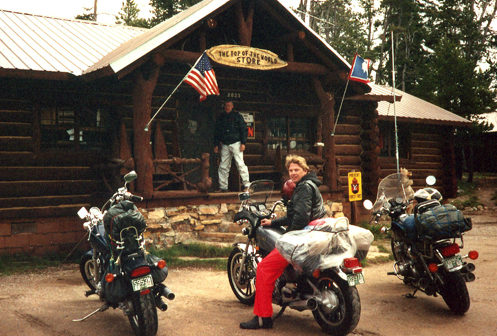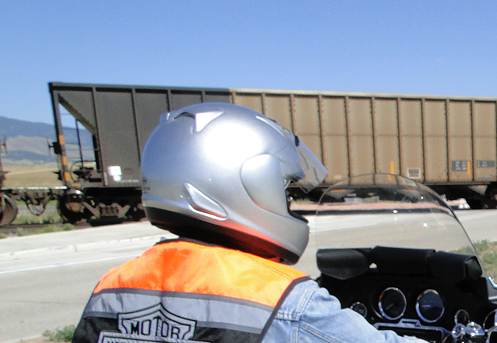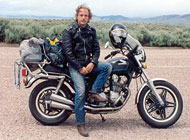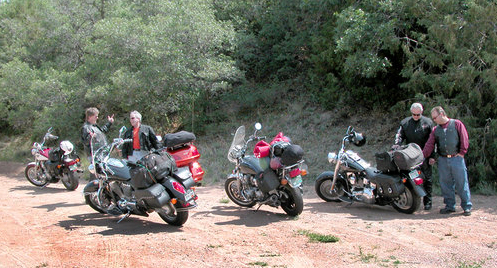
Riding with friends doesn’t mean riding just like your friends.
Motorcycle riding, like so much else in life, is a matter of learning by doing. The following are a dozen lessons learned through more than 25 years and 100,000 miles on two wheels.
1. Get yourself some friends
If you’re not carrying a passenger, riding is a solitary activity at its core. You can be with other people but when you’re running down the road you’re all alone on that bike. That makes it all the more enjoyable to have friends with you when you stop. “Wow, did you see that bald eagle on top of that tree?” “Did that jerk come as close to running you off the road as it looked like from my view?” “Which direction do you think we ought to head now?”
Plus, if you go down it’s awfully nice to have friends to come to the rescue. Riding buddies are a good thing.
2. Signal your intentions
Cagers (people in cars) are generally the biggest threat to bikers but sometimes your buddies can be a threat, too. Does that pull-out on the left have a great view? Fine, pull off, but don’t assume the guys following you know why you’re slowing down. Signal your intent. For all you know, the guy behind you is impatient with your slow speed and is just about to pull around you to pick up the pace. If you make a left just as he twists the throttle your trip could come to an unpleasant end. Don’t let that happen.
3. Ride your own ride
Next to brain-dead cagers, the majority of motorcycle accidents are of the single-vehicle variety. That frequently means the rider pushed beyond their ability. This is the kind of thing that can happen when you’re riding with others and the leader is setting an aggressive pace. You may not be comfortable taking these tight turns at this speed but you want to keep up.
Bad idea. You can always catch up later. Don’t put yourself at risk when safety is at stake. Ride your own ride.
4. Don’t hesitate to go it alone
As enjoyable as it is to ride with friends, sometimes they’ve all got other plans. If you take off on your own you may find the freedom to stop when you want, go where you want, and do whatever your heart desires to be downright addictive. Of course it doesn’t hurt to have a cell phone with you in case you have trouble, but don’t pass up a great riding day just because you can’t find someone to join you.
5. Make like a Boy Scout and always “be prepared”
Sure, the sun is shining and it’s warm now, but don’t let that persuade you that you don’t need rain gear or warm clothes. It’s guaranteed to be very unpleasant if you find yourself out miles from anywhere and the skies open up. Particularly if you have saddle bags, there’s really no excuse for not carrying the gear you might need at all times.
6. Know your bike
Modern motorcycles are extremely reliable but user error can thwart the best technological design. Here’s a real-life example. Most bikes have petcocks that switch between the regular fuel supply and the reserve. On most bikes, the three positions for that lever are “Open,” “Shut,” and “Reserve.”
On some Kawasakis, however, the positions are “Open,” Reserve,” and “Prime.” Perhaps you don’t pay attention to this difference, and, after filling up, switch from Reserve to Open–you think. But in fact you have switched from Reserve to Prime. The next time you start up the bike it barely runs. Why? Because with that petcock in the Prime position it has been dribbling fuel into the cylinders continually, and that fuel has been seeping past your rings into the oil pan. Bikes don’t run well with their oil pans full of gasoline. (Hint: I did this twice before I figured it out.)
Get thoroughly acquainted with your motorcycle and everyone will be much happier.
7. Get schooled
Numerous studies show that the majority of motorcyclists who get killed on the road have not taken any sort of rider training. What more do you need to know?
8. Assume you’re invisible
The most common phrase spoken by a cager who just hit a motorcyclist is “I didn’t see him.” It doesn’t matter why this is, it matters that you take it to heart. If you pretend to yourself that you are invisible, and ride as if that were true, you’ll make decisions that will usually negate that driver’s inattention.
9. Take your time
Sometimes the best part of the trip is the unplanned, unscheduled stop or sidetrip. If you’re in too big a hurry to stop and enjoy the trip you might as well go by car.
10. Lean into adventure
This goes hand in hand with taking your time. The best motorcycle roads are the ones less traveled by cars, trucks, RVs, and the like. Don’t look for the shortest distance between two points, those roads are straight. Find the roads that curve.
11. Be opportunistic
“If you don’t like the weather, wait five minutes.” Numerous parts of the country claim this line, and it’s something to take in consideration. If you want to go for a ride today and it’s gorgeous right now, go right now. You just don’t know what the sky will look like two hours from now.
12. Pick it up!
Amazing as it may seem, even petite women can pick up huge, heavy motorcycles laying on the ground. It’s all a matter of technique. Use the wrong technique and at best you will fail, and if it gets worse you may get a hernia. Learn how to pick up your machine and you won’t end up looking like a fool – or worse, in the hospital.
Biker Quote for Today
Why motorcycles are better than men: Motorcycles don’t insult you if you are a bad rider.
